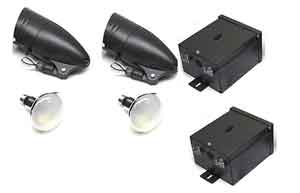Flagpole Lighting |
|
Example Flagpole Lighting Photometric
The commercial lighting design therefore has complete freedom to select appropriate equipment that will appropriately light the flag and work in harmony with the entirety of the photometric lighting design.
While up lighting is being systematically phased out in many parts of the country, there are many places that still permit it. In these areas, flagpole lighting is still being done with either inground fixtures or above ground fixtures that shine light up the pole onto the flag. Either type is highly effective, depending on the size of the flag, the location of the pole, and the amount of luminance in the general environment as well.
For applications that really need to minimize glare, inground flagpole lighting fixtures are recommended. Their placement underground acts as a shield. Fixture aim determines the degree of illumination.
Businesses and electrical contractors can obtain any number of inground fixtures that are equipped with halogen, LED, or HID lamps.
For HID applications where higher levels of luminance are mandatory, above ground fixtures are recommended. These luminaires can be mounted to conduits or junction boxes and aimed directly up at the flag. HID lamps feature much higher wattages and work essentially like a form of floodlight.
Again, beam width and intensity depends completely on lamp strength and angle of incidence.
A photometric analysis of the entire site, including the flag pole, is the best way to go about selecting the right type of lamp. Not only will it take into account the size of the flag, the height of the flagpole, but it will also balance the flag light with the amount of ambient light present in the immediate surroundings.
We see this, for instance, at a car dealership with a 30-foot flagpole. The bright lights of the dealership are already going to light both the flag and the pole. To add additional emphasis to it, however, HID above ground lights can be angled at just the right vector to make it stand out from its surroundings.
LED flagpole lighting is an excellent alternative to HID sources that saves power costs and helps promote a greener environment. There only current drawback is they are still not bright enough to light larger poles and flags. For small businesses, however, they are ideal because flags in these areas are generally no more than 15 feet off the ground. Parks and subdivisions also prefer LED under similar circumstances for the green energy savings it provides.
Although not as powerful as halogens, LED lights work just fine in these areas because there seldom is much, if any, ambient light to compete with their luminance.
However, flagpole lighting is becoming increasingly complicated with the passage of dark sky laws that prohibit all forms of up lighting. In these areas, a lighting designer will have to do a systematic photometrical analysis of the grounds and devise a method of down lighting the flag so it will comply with both Federal law and local ordinances.
This is by no means impossible, or even as difficult as it may sound, for RLLD Commercial Lighting’s advanced photometric software and 3D lighting system models.
RLLD Commercial Lighting carries a wide variety of industrial & commercial lighting fixtures. If you can not find what you are looking for call us toll free at 1-866-654-3961 and we will find it for you. Our home office is located in Houston, Texas with warehouses located throughout the United States that enable us to service all 50 states. |
Back to main topic: Flag Lights |
| Contact Us |
|
|
| Products |
| Articles |
|
| Information |
|
